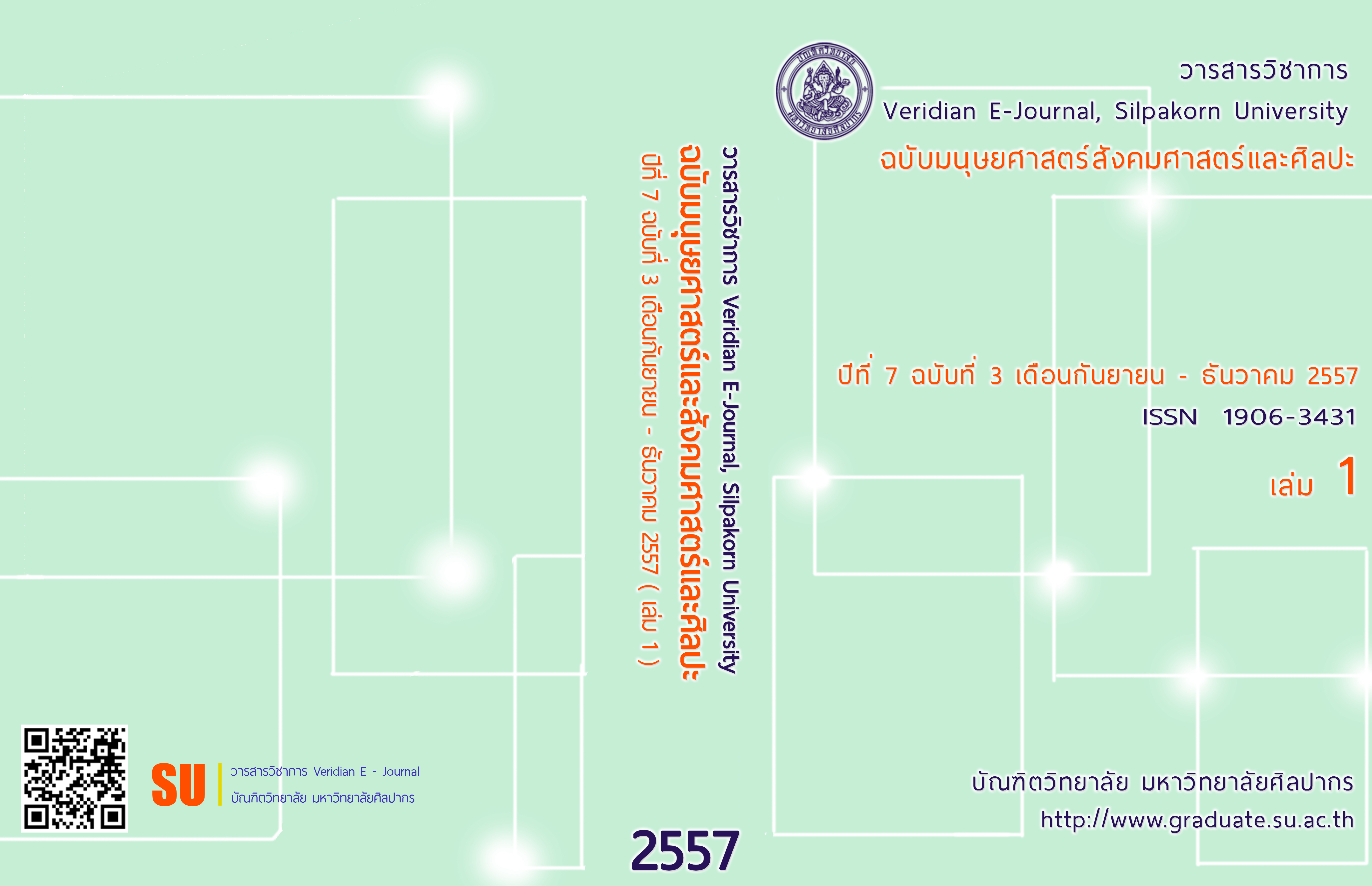การพัฒนารูปแบบการจัดการศึกษาตามอัธยาศัยในสถานศึกษาขั้นพื้นฐาน สำหรับนักเรียนระดับมัธยมศึกษาตอนต้นที่ออกกลางคัน
Main Article Content
บทคัดย่อ
บทคัดย่อ
การพัฒนารูปแบบการจัดการศึกษาตามอัธยาศัยในสถานศึกษาขั้นพื้นฐานสำหรับนักเรียนระดับมัธยมศึกษาตอนต้นที่ออกกลางคัน มีความมุ่งหมายของการวิจัยเพื่อ 1) สร้างรูปแบบการจัดการศึกษาตามอัธยาศัยในสถานศึกษาขั้นพื้นฐานสำหรับนักเรียนระดับมัธยมศึกษาตอนต้นที่ออกกลางคัน 2) ศึกษาประสิทธิผลการใช้รูปแบบการจัดการศึกษาตามอัธยาศัยในสถานศึกษาขั้นพื้นฐานสำหรับนักเรียนระดับมัธยมศึกษาตอนต้นที่ออกกลางคัน 3) ประเมินรูปแบบการจัดการศึกษา ตามอัธยาศัยในสถานศึกษาขั้นพื้นฐานสำหรับนักเรียนระดับมัธยมศึกษาตอนต้นที่ออกกลางคัน ซึ่งได้ดำเนินการวิจัยตามขั้นตอนดังนี้
ตอนที่ 1 การสร้างรูปแบบการจัดการศึกษาตามอัธยาศัยในสถานศึกษาขั้นพื้นฐาน สำหรับนักเรียน ระดับมัธยมศึกษาตอนต้นที่ออกกลางคัน ดำเนินการโดย การวิเคราะห์แนวคิดทฤษฎีการศึกษา หลักสูตรการจัดการศึกษา แนวคิดการจัดการศึกษาตามอัธยาศัย และกฎหมายที่เกี่ยวข้องกับการจัดการศึกษา สังเคราะห์เป็นร่างรูปแบบการจัดการศึกษาตามอัธยาศัยในสถานศึกษาขั้นพื้นฐานสำหรับนักเรียนระดับมัธยมศึกษาตอนต้นที่ออกกลางคัน
นำไปให้ผู้เชี่ยวชาญ จำนวน 9 คนพิจารณาด้วยวิธีการสนทนากลุ่ม (Focus Group) นำข้อมูลที่ได้จากการสนทนากลุ่ม(Focus Group) มาวิเคราะห์เชิงเนื้อหา (Content Analysis) กำหนดเป็นรูปแบบการจัดการศึกษาตามอัธยาศัยในสถานศึกษาขั้นพื้นฐานสำหรับนักเรียนระดับมัธยมศึกษาตอนต้นที่ออกกลางคัน
ตอนที่ 2 การศึกษาประสิทธิผลการใช้รูปแบบการจัดการศึกษาตามอัธยาศัยในสถานศึกษาขั้นพื้นฐานสำหรับนักเรียนระดับมัธยมศึกษาตอนต้นที่ออกกลางคัน เป็นศึกษาภาคสนาม โดยใช้การวิจัยเชิงทดลองกับนักเรียนที่ออกกลางคันในโรงเรียน ที่เปิดสอนระดับมัธยมศึกษาตอนต้น เพื่อศึกษาประสิทธิผลของรูปแบบด้วยการเก็บข้อมูลภาคสนาม ประชากรเป็นโรงเรียนที่เปิดสอนระดับมัธยมศึกษาตอนต้น สังกัดสำนักงานคณะกรรมการการศึกษาขั้นพื้นฐาน กลุ่มตัวอย่างที่ใช้ในการศึกษา ได้มาโดยวิธีการสุ่มอย่างง่าย (Simple Random Sampling) ได้กลุ่มตัวอย่างเป็นโรงเรียนวัดบางพระ สังกัดสำนักงานเขตพื้นที่การศึกษาประถมศึกษานครปฐม เขต 2 การเก็บรวบรวมข้อมูลระหว่างวันที่ 1 มกราคม 2557 ถึงวันที่ 31 มีนาคม 2557 ตามแบบวิเคราะห์ข้อมูลการทดลองใช้รูปแบบ, แบบวิเคราะห์อัตราการขาดเรียนที่ลดลง และแบบวิเคราะห์การผ่านเกณฑ์ การประเมินผลการเรียนรายวิชา วิเคราะห์ข้อมูลด้วยค่าความถี่ ค่าร้อยละ ค่าเฉลี่ย (Mean)
ตอนที่ 3 การประเมินรูปแบบการจัดการศึกษาตามอัธยาศัยในสถานศึกษาขั้นพื้นฐาน สำหรับนักเรียนระดับมัธยมศึกษาตอนต้นที่ออกกลางคัน ดำเนินการโดย จัดประชุมสัมมนาเพื่อนำเสนอผลการทดลองใช้รูปแบบการจัดการศึกษาตามอัธยาศัยในสถานศึกษาขั้นพื้นฐานสำหรับนักเรียนระดับมัธยมศึกษาตอนต้นที่ออกกลางคัน ประชากร
ได้แก่ ผู้บริหารสถานศึกษาในโรงเรียนที่เปิดสอนระดับมัธยมศึกษาตอนต้นของจังหวัดนครปฐม สังกัดสำนักงานคณะกรรมการการศึกษาขั้นพื้นฐาน กลุ่มตัวอย่าง จำนวน 30 คน ได้มาโดยวิธีการสุ่มอย่างง่าย (Simple Random Sampling) แล้วประเมิน เพื่อตรวจสอบความเหมาะสม ความเป็นไปได้ โดยใช้แบบสอบถามความคิดเห็น มีลักษณะเป็นแบบสอบถามมาตราส่วนประมาณค่า (Rating Scale) 5 ระดับ เก็บรวบรวมข้อมูล ในวันที่ 28 พฤษภาคม 2557 เวลา 09.00 น. ถึง 12.00 น. ณ ห้องประชุมโรงแรมเวล อำเภอเมือง จังหวัดนครปฐม จำนวน 30 ฉบับ คิดเป็นร้อยละ 100 วิเคราะห์ข้อมูลด้วยค่าความถี่ ค่าร้อยละ ค่าเฉลี่ย (Mean) และความเบี่ยงเบนมาตรฐาน (Standard Deviation)
ผลการวิจัยสรุปได้ดังนี้
1. รูปแบบการจัดการศึกษาตามอัธยาศัยในสถานศึกษาขั้นพื้นฐานสำหรับนักเรียนระดับมัธยมศึกษาตอนต้นที่ออกกลางคัน มีโครงสร้าง 4 ด้านโดยสรุปดังนี้ 1) ด้านการบริหารจัดการ ประกอบด้วย โครงสร้างการบริหารจัดการศึกษา ,บทบาทหน้าที่การบริหารจัดการศึกษา ,การบริหารจัดการศึกษา 2) ด้านหลักสูตรการศึกษา ประกอบด้วย หลักสูตรแกนกลางการศึกษาขั้นพื้นฐาน พุทธศักราช 2551 และการจัดเรียนรู้ตามอัธยาศัย 3) ด้านกระบวนการการจัดการเรียนรู้ ประกอบด้วย การจัดการเรียนรู้ ,กระบวนการจัดการเรียนรู้, การออกแบบการจัดการเรียนรู้, บทบาทของผู้สอน ,สื่อการสอน,แหล่งการเรียนรู้ 4) ด้านการวัดผลและประเมินผล ประกอบด้วย การวัดผลและประเมินผลตามหลักสูตรแกนกลางการศึกษาขั้นพื้นฐาน พุทธศักราช 2551 , วิธีการวัดผลและการประเมินผลอย่างหลากหลาย
2. การศึกษาประสิทธิผลของรูปแบบการจัดการศึกษาตามอัธยาศัย ในสถานศึกษาขั้นพื้นฐานสำหรับนักเรียนระดับมัธยมศึกษาตอนต้นที่ออกกลางคัน พบว่า
2.1 อัตราการขาดเรียนที่ลดลงของนักเรียนที่ออกกลางคัน เฉลี่ยร้อยละ 87.45
2.2 การผ่านเกณฑ์การประเมินผลการเรียนรายวิชาของนักเรียนที่ออกกลางคันเฉลี่ยร้อยละ 66.67
3. การประเมินรูปแบบการจัดการศึกษาตามอัธยาศัยในสถานศึกษาขั้นพื้นฐานสำหรับนักเรียนระดับมัธยมศึกษาตอนต้นที่ออกกลางคัน มีความเหมาะสมอยู่ในระดับมาก (X= 4.46, SD=0.90) และความเป็นไปได้อยู่ในระดับมาก (X= 4.46, SD=0.17)'
Abstract
This research is aimed: 1) to construct the informal education model in the schools of basic education for the drop out secondary school students, 2) to study the efficiency of informal education model in the schools of basic education for the drop out secondary school students, and 3) to evaluate the informal education model in the schools of basic education for the drop out secondary school students. The research was investigated following the three procedures below:
Part 1: The construction of informal education model in the schools of basic education for the drop out secondary school students.
The model was constructed by analyzing the theory of education, education courses, the concept of informal education and the law of education. After that, the researcher synthesized the informal education model, a draft model. The draft model was approved by nine experts through using focus group discussion. The collected data were analyzed by content analysis and develop model of informal education model in the schools of basic education for the drop out secondary school students.
Part 2: The investigation of the effectiveness of informal education model in the schools of basic education for the drop out secondary school students.
This was the field research by using experimental research with the drop out secondary school students. The population for this study were the secondary schools of basic education under the jurisdiction of the Office of the Basic Education Commission. The sample group of this study was Watbangpra School, by simple random sampling. The school is under the jurisdiction of Nakhon Pathom Primary Educational Service Area Office 2. The data was collected using three analysis form; the implementation data analysis form, the analysis rates of school absenteeism decreased form and the criteria to evaluate the course form. The collection period of data was during January, 2014 to March, 2014. The data were analyzed by frequency, percentage and mean score.
Part 3: Evaluation the model of informal education in the schools of basic education for the drop out secondary school students.
The population was composed of thirty administrators from the secondary schools in Nakhon Pathom province, under the jurisdiction of the Office of the Basic Education Commission. The samples were from simple random sampling attend the conference. The researcher present the results of implementation the informal education model in the schools of basic education for the drop out secondary school students. After the conference to the researcher evaluated the appropriate, possibility and development of using the model. The measuring instrument was the questionnaire with the school administrators which contained five rating scale. The period of data collection was on 28th May, 2014 at Whale Hotel, Muang District, Nakhon Pathom province. There were 100 percent of collection data from all samples. The data was analyzed by frequency, percentage, mean and standard deviation.
The results of this research are the following :
1. The informal education model in the schools of basic education for the drop out secondary school students has four structures; 1) the management part which includes the management structure, the management role and education management, 2) the curriculum which includes the basic education core curriculum B.E. 2551 (A.D. 2008) and the informal education, 3) the process of learning which includes the learning management, the process of learning, the designing of learning management, teachers’ role, instruction media, learning resources, 4) measurement and evaluation part included the measurement and evaluation follow the basic education core curriculum B.E. 2551 (A.D. 2008) and the variety of ways of assessment.
2. The investigation of the effectiveness of informal education model in the schools of basic education for the drop out secondary school students. The results were found that
2.1 The drop out students were reduced at 87.45 percentage.
2.2 The drop out students passed the criterion evaluation of learning according to the basic education core curriculum B.E. 2551 (A.D. 2008) at 66.67 percentage.
3. The result of appropriate evaluation was effective at the high level at X= 4.46, SD=0.90. The possibility evaluation was at the high level at X= 4.46, SD=0.17.

